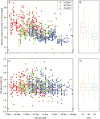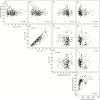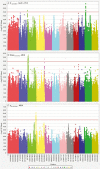Variation in seed longevity among diverse Indica rice varieties
- PMID: 31180503
- PMCID: PMC6798842
- DOI: 10.1093/aob/mcz093
Variation in seed longevity among diverse Indica rice varieties
Abstract
Background and aims: Understanding variation in seed longevity, especially within closely related germplasm, will lead to better understanding of the molecular basis of this trait, which is particularly important for seed genebanks, but is also relevant to anyone handling seeds. We therefore set out to determine the relative seed longevity of diverse Indica rice accessions through storage experiments. Since antioxidants are purported to play a role in seed storability, the antioxidant activity and phenolic content of caryopses were determined.
Methods: Seeds of 299 Indica rice accessions harvested at 31, 38 and 45 d after heading (DAH) between March and May 2015 and differing in harvest moisture content (MC) were subsequently stored at 10.9 % MC and 45 °C. Samples were taken at regular intervals and sown for germination. Germination data were subjected to probit analysis and the resulting parameters that describe the loss of viability during storage were used for genome-wide association (GWA) analysis.
Key results: The seed longevity parameters, Ki [initial viability in normal equivalent deviates (NED)], -σ-1 (σ is the time for viability to fall by 1 NED in experimental storage) and p50 [time for viability to fall to 50 % (0 NED)], varied considerably across the 299 Indica accessions. Seed longevity tended to increase as harvest MC decreased and to decrease as harvest MC increased. Eight major loci associated with seed longevity parameters were identified through GWA analysis. The favourable haplotypes on chromosomes 1, 3, 4, 9 and 11 enhanced p50 by ratios of 0.22-1.86.
Conclusions: This is the first study to describe the extent of variation in σ within a species' variety group. A priori candidate genes selected based on rice genome annotation and gene network ontology databases suggested that the mechanisms conferring high seed longevity might be related to DNA repair and transcription, sugar metabolism, reactive oxygen species scavenging and embryonic/root development.
Keywords: Oryza sativa L; GWAS; Genebank; Indica variety group; rice; seed longevity; seed storage; viability monitoring.
© The Author(s) 2019. Published by Oxford University Press on behalf of the Annals of Botany Company.
Figures







Similar articles
-
Increases in the longevity of desiccation-phase developing rice seeds: response to high-temperature drying depends on harvest moisture content.Ann Bot. 2015 Aug;116(2):247-59. doi: 10.1093/aob/mcv091. Epub 2015 Jul 1. Ann Bot. 2015. PMID: 26133688 Free PMC article.
-
Genome-wide association mapping revealed a diverse genetic basis of seed dormancy across subpopulations in rice (Oryza sativa L.).BMC Genet. 2016 Jan 25;17:28. doi: 10.1186/s12863-016-0340-2. BMC Genet. 2016. PMID: 26810156 Free PMC article.
-
Screening of NIAS World Rice Core Collection for Seeds with Long Longevity as Useful Potential Breeding Materials Focusing on the Stability of Embryonic RNAs.Plants (Basel). 2024 Jul 6;13(13):1869. doi: 10.3390/plants13131869. Plants (Basel). 2024. PMID: 38999709 Free PMC article.
-
Long-Term Storage and Longevity of Orthodox Seeds: A Systematic Review.Front Plant Sci. 2020 Jul 3;11:1007. doi: 10.3389/fpls.2020.01007. eCollection 2020. Front Plant Sci. 2020. PMID: 32719707 Free PMC article.
-
Seedling establishment: The neglected trait in the seed longevity field.Plant Physiol Biochem. 2023 Jul;200:107765. doi: 10.1016/j.plaphy.2023.107765. Epub 2023 May 14. Plant Physiol Biochem. 2023. PMID: 37209453 Review.
Cited by
-
Population structure and genetic diversity characterization of soybean for seed longevity.PLoS One. 2022 Dec 6;17(12):e0278631. doi: 10.1371/journal.pone.0278631. eCollection 2022. PLoS One. 2022. PMID: 36472991 Free PMC article.
-
Advances in the Identification of Quantitative Trait Loci and Genes Involved in Seed Vigor in Rice.Front Plant Sci. 2021 Jul 14;12:659307. doi: 10.3389/fpls.2021.659307. eCollection 2021. Front Plant Sci. 2021. PMID: 34335643 Free PMC article. Review.
-
Novel Sources of Pre-Harvest Sprouting Resistance for Japonica Rice Improvement.Plants (Basel). 2021 Aug 19;10(8):1709. doi: 10.3390/plants10081709. Plants (Basel). 2021. PMID: 34451754 Free PMC article.
-
Quantitative Trait Locus Mapping of Seed Vigor in Soybean under -20 °C Storage and Accelerated Aging Conditions via RAD Sequencing.Curr Issues Mol Biol. 2021 Nov 12;43(3):1977-1996. doi: 10.3390/cimb43030136. Curr Issues Mol Biol. 2021. PMID: 34889905 Free PMC article.
-
RicePilaf: a post-GWAS/QTL dashboard to integrate pangenomic, coexpression, regulatory, epigenomic, ontology, pathway, and text-mining information to provide functional insights into rice QTLs and GWAS loci.Gigascience. 2024 Jan 2;13:giae013. doi: 10.1093/gigascience/giae013. Gigascience. 2024. PMID: 38832465 Free PMC article.
References
-
- Angelovici R, Galili G, Fernie AR, Fait A. 2010. Seed desiccation: a bridge between maturation and germination. Trends in Plant Science 15: 211–218. - PubMed
-
- Bailly C. 2004. Active oxygen species and antioxidants in seed biology. Seed Science Research 14: 93–107.
-
- Bailly C, Audigier C, Ladonne F, et al. 2001. Changes in oligosaccharide content and antioxidant enzyme activities in developing bean seeds as related to acquisition of drying tolerance and seed quality. Journal of Experimental Botany 52: 701–708. - PubMed
-
- Bewley JD, Black M. 1994. Seeds: physiology of development and germination. New York: Plenum Press.
Publication types
MeSH terms
LinkOut - more resources
Full Text Sources
Research Materials

